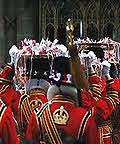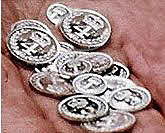
For Coin, Token, Banknote and Medal collectors in the Hornchurch, Romford and Upminster area
Charity begins at home. By Pam Williams
Many people are familiar with Maundy Thursday, but do not really know much about or about Maundy money. In this article I have delved into the background.
The Maundy service is Christian in origin. There are several suggestions as to the origin of the name but the most generally accepted is from the Latin ‘mandatum’ which means an order and is said to come from the order given by Jesus to his disciples after washing their feet on the day before the first Good Friday.
The observance of this custom has been traced back to the 4th century, and an account shows that it was being carried out by St. Brendan and his monks in the 6th century. The first English monarch recorded to have washed feet was Edward II, who, we are told, washed the feet of fifty poor men in the nineteenth year of his reign. It also became customary for the monarch to provide a meal, together with gifts of clothing, food and money for the poor people involved. In 1363 when Edward III was fifty years old he gave food and clothing to fifty men. In 1556 Queen Mary presented the robe she had worn to the oldest and poorest woman present at the feet washing ceremony.
The water used by the monarch for washing the feet was sweetened by the addition of wine, flowers and herbs in the hope they would ward off any infection. There were also nosegays around for the say reason, and today the Queen and clergy carry posies, the traditional protection against fever and plague.
James II is credited with being the last sovereign to perform the feet washing ceremony, but there is a record that William III washed the feet of 12 poor men. By then, however, the washing operation had been simplified. It was done by sprinkling the feet with a sprig of hyssop dipped in water. It gradually came to be delegated to the Lord High Almoner, the Archbishop of Canterbury, and by the mid-28th century it was discontinued. Today the clergy remove their vestments during the ceremony and are clad only in white, with a linen towel on the shoulder to commemorate the custom of washing the feet.
The four Georges gave alms liberally, together with generous helping of boiled beef and shoulder of mutton, but by Queen Victoria’s time the feast had been dropped and the Royal Maundy became more like the ceremony we know today. For a time she continued to give clothing, mostly woollens, but eventually substituted a purse of money, since when money only has been distributed.
The present Queen makes a point of attending the Maundy ceremony and distributing the Maundy money herself. Since 1953 when Westminster Abbey was being prepared for the Coronation the practice has sprung up of holding the Maundy service and distribution in other cathedrals. This year it was on Tuesday, 3rd March at Gloucester Cathedral. Because Westminster Abbey had been used every year up to this time the broad stone seat in the northern-most bay on the West side of the East Cloister is known as the Maundy bench.
 The
money is in small leather purses, some red, some white, with long string.
It is carried on a large gold alms-dish by a Yeoman of the Guard. The
red purses contain the money given in place of food and clothing. In
the white purse is the Maundy money. This consists of specially minted
silver coins to the value of one penny, twopence, threepence and fourpence
of the same size as those minted in the reign of Charles II. The earliest
so-called Maundy money up to the time of George II was merely the ordinary
current coin of the realm. After this it was specially struck. The amount
given is at the rate of one penny for each year of the sovereign’s age.
Thus in 1965 the 39 men and 39 women chosen from the diocese of Canterbury
received coins to the value of 39 pence at the ceremony in Canterbury
Cathedral.
The
money is in small leather purses, some red, some white, with long string.
It is carried on a large gold alms-dish by a Yeoman of the Guard. The
red purses contain the money given in place of food and clothing. In
the white purse is the Maundy money. This consists of specially minted
silver coins to the value of one penny, twopence, threepence and fourpence
of the same size as those minted in the reign of Charles II. The earliest
so-called Maundy money up to the time of George II was merely the ordinary
current coin of the realm. After this it was specially struck. The amount
given is at the rate of one penny for each year of the sovereign’s age.
Thus in 1965 the 39 men and 39 women chosen from the diocese of Canterbury
received coins to the value of 39 pence at the ceremony in Canterbury
Cathedral.

In 2008, the white leather purse contained silver Maundy coins matching the Queen's age in pence - 82p, while the red purse contains ordinary money.
In 2009, 83 male and 83 female pensioners received 83p in Maundy Money, because the Queen is 83 years old this year.
 These
coins are, by special dispensation legal tender, although for many years
they were not included in the trial of the Pyx, as it was not meant
to be available to the General Public. Most recipients are proud to
keep them although “The Observer” reported on April 10th 1965 that some
dealers were prepared to offer as much as £75 for a white purse containing
a set of 39 coins. I wonder what it would be worth now?
These
coins are, by special dispensation legal tender, although for many years
they were not included in the trial of the Pyx, as it was not meant
to be available to the General Public. Most recipients are proud to
keep them although “The Observer” reported on April 10th 1965 that some
dealers were prepared to offer as much as £75 for a white purse containing
a set of 39 coins. I wonder what it would be worth now?
